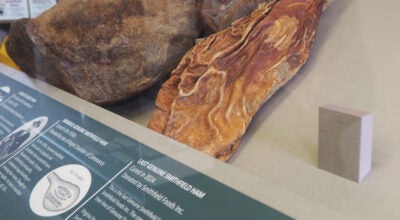Isle of Wight planners delay vote on Prairie solar farm following opposition
Published 5:50 pm Wednesday, March 1, 2023

- A conceptual plan for the Prairie solar farm shows panels buffered by at least 600 feet of untouched land along Longview Drive.
A proposed 432-acre solar farm along Longview Drive drew near-unanimous opposition at a Feb. 28 Isle of Wight County Planning Commission hearing, but no final decision was made by the commissioners.
Energix, an Israeli company with its United States offices headquartered in Arlington, is proposing a 20-megawatt facility named “Prairie Solar.”
Prairie would be located within one to two miles of the existing 180-acre Woodland solar farm, also on Longview Drive. Woodland is presently the only operational solar farm in Isle of Wight County, though a total of six have been approved to date.
Longview Drive, also known as State Route 602, spans roughly 6.3 miles from its intersection with Bowling Green Road near Darden’s Country Store to the Everets community on the Suffolk side of the county-city border.
Nine speakers spoke during the roughly half-hour public hearing, only one in support for the project.
Among Prairie’s opponents are Christopher Cavallo of Smithfield, who pushed to revitalize farming as a way of life rather than allow farmlands to be leased or purchased by solar developers.
“We don’t need to sell out our way of life; we need to embrace it,” Cavallo said.
Longview Drive resident Robert Black contended that Sandy Ridge Drive, a 15-foot-wide road that connects to Longview, is too narrow for the two-way truck traffic that would result during the solar farm’s construction.
He’d joined with neighbors last year in opposing a then-proposed “borrow pit” sand mining operation on Suffolk’s side of the border that proposed using Longview and another narrow road, Shady Pine Lane, through Isle of Wight as its access. Isle of Wight officials, using their own trucks, had taken photographs last year on Sandy Ridge Drive and sent them to Suffolk officials, showing it to be impossible for the two to pass each other without one running off the road. The borrow pit’s developer, Ryan Nelms, withdrew his zoning application to Suffolk earlier this year.
Alexandra Rose, speaking for landowner Everets Properties, was the only person to speak in favor of the Prairie project. She told commissioners the land has been in her family for six generations, and that they had to shut down the family saw mill in 2007 due to economic reasons. The Prairie lease, she said, would be a way to keep the land in her family.
Allie Ondash, a project development associate with Energix, told the commissioners that of the 432 total acres that would form the project site, only 152 would be fenced and contain solar panels. Roughly 122 acres would continue to be used by Everets Properties for timber farming.
The project site would be at least 600 feet from the road and surrounded by a 50-foot-wide vegetative buffer.
A Prairie fact sheet presented at a Feb. 1 informational meeting at Christian Home Baptist Church states the 20 megawatts produced would be enough to power more than 5,000 homes for one year and offset approximately 29,500 metric tons of carbon dioxide. The project is projected to create a $4.4 million economic output, including $3.3 million in real estate and machinery and tools tax revenues over its 35-year lifespan.
Prairie proposes to use American-made solar panels from Ohio-based First Solar. Unlike the typical silicon-based panels, First Solar’s panels contain cadmium Telluride, or CdTe.
Energix has shared a 2019 study prepared for First Solar by Virginia Tech’s Virginia Center for Coal and Energy Research. It concludes CdTe panels “pose little to no risk under normal operating conditions and foreseeable accidents such as fire, breakage, and extreme weather events like tornadoes and hurricanes.” A 2017 study published in the National Library of Medicine found CdTe solar cells released 73% of their cadmium and 21% of their tellurium over 30 days when subjected to a Toxicity Characterization leaching Procedure, or TCLP, which tests damaged and end-of-life panels to determine if they’ll leach toxic materials. The 2017 study, Energix officials contend, was conducted on “non-encapsulated” modules “not representative” of First Solar’s products.
According to a frequently-asked-questions document by First Solar, the company’s modules contain CdTe in the panels’ semiconductor layer, which would have a thickness roughly equivalent to 3% of the diameter of a human hair. The semiconductor layer would be encapsulated between two sheets of glass to limit the release into the environment in the event of fire or breakage.
Asked by Commissioner Thomas Distefano whether the First Solar panels would pass a TCLP test, Energix officials stated they would.
Commissioner Jennifer Boykin, however, noted that Energix was facing two Virginia Department of Environmental Quality fines pertaining to solar farms in Buckingham and Wythe counties. According to reporting by The Farmville Herald, the DEQ issued a draft order fining Energix $23,773 last year after state inspectors in 2021 found 200 feet of sediment contamination in a stream near the 20-megawatt, 470-acre Buckingham site, among other violations.
Sediment, the Herald reports, is the loose sand and clay that stormwater carries into nearby bodies of water, and can cause toxic algae blooms that harm wildlife. The DEQ’s Piedmont Regional Office confirmed to the Herald in July that as of that date, Energix had removed the sediment from the stream.
Energix, as of 2022, was facing another $68,250 DEQ fine for similar violations at its Wythe County site.
Ondash told Boykin that Energix has been working with the DEQ and Virginia Tech to resolve any remaining issues.
Planning Commission Chairman Brian Carroll noted that in addition to the verbal comments, the commissioners had received four letters, three in support and one in opposition to the Prairie project.
Distefano, citing a draft ordinance that would limit the cumulative acreage of existing and proposed solar farms in the county to 2% of Isle of Wight’s prime farmland, and the pending formation of an “energy task force,” made a motion to table voting on the Prairie application. Distefano’s motion passed unanimously.





